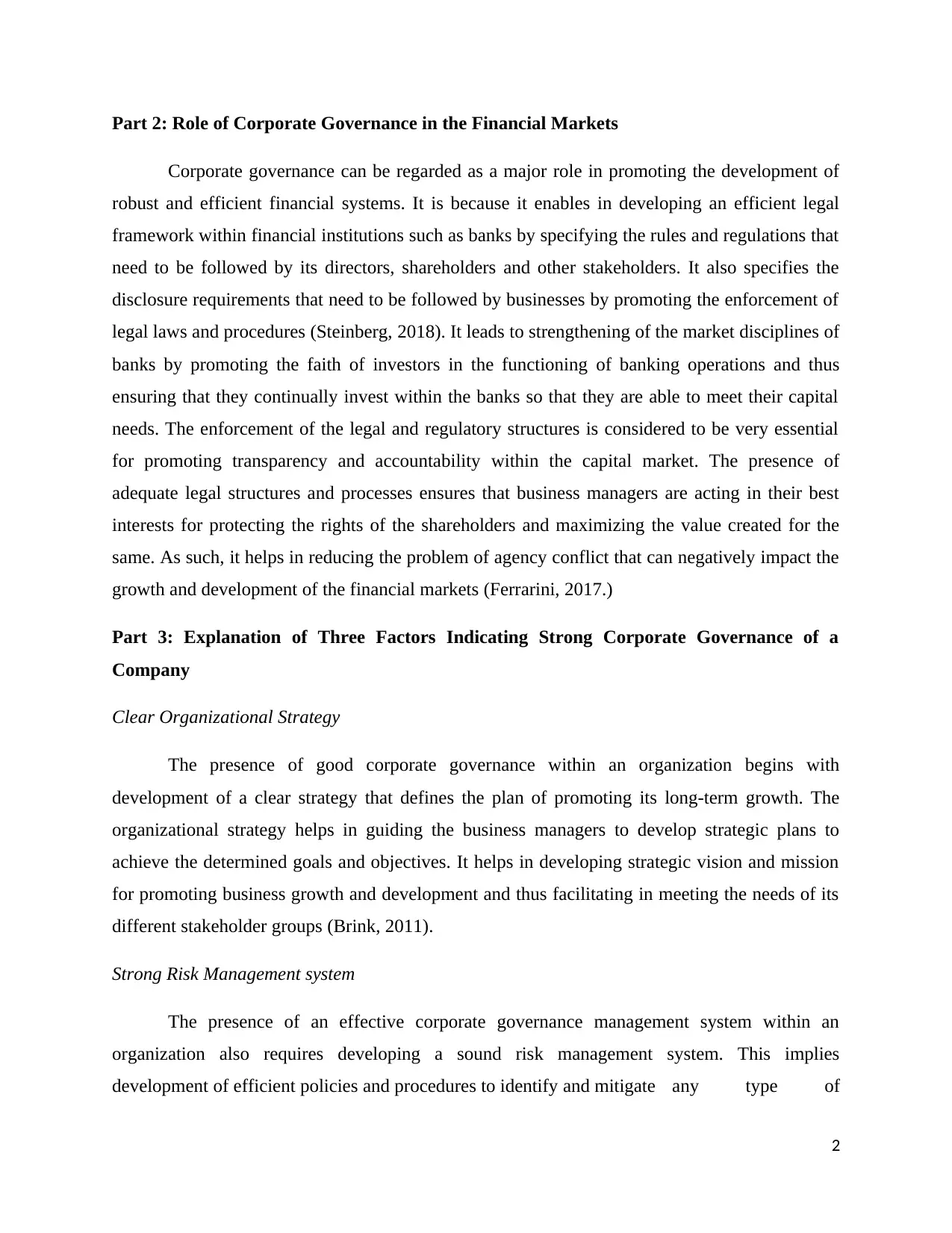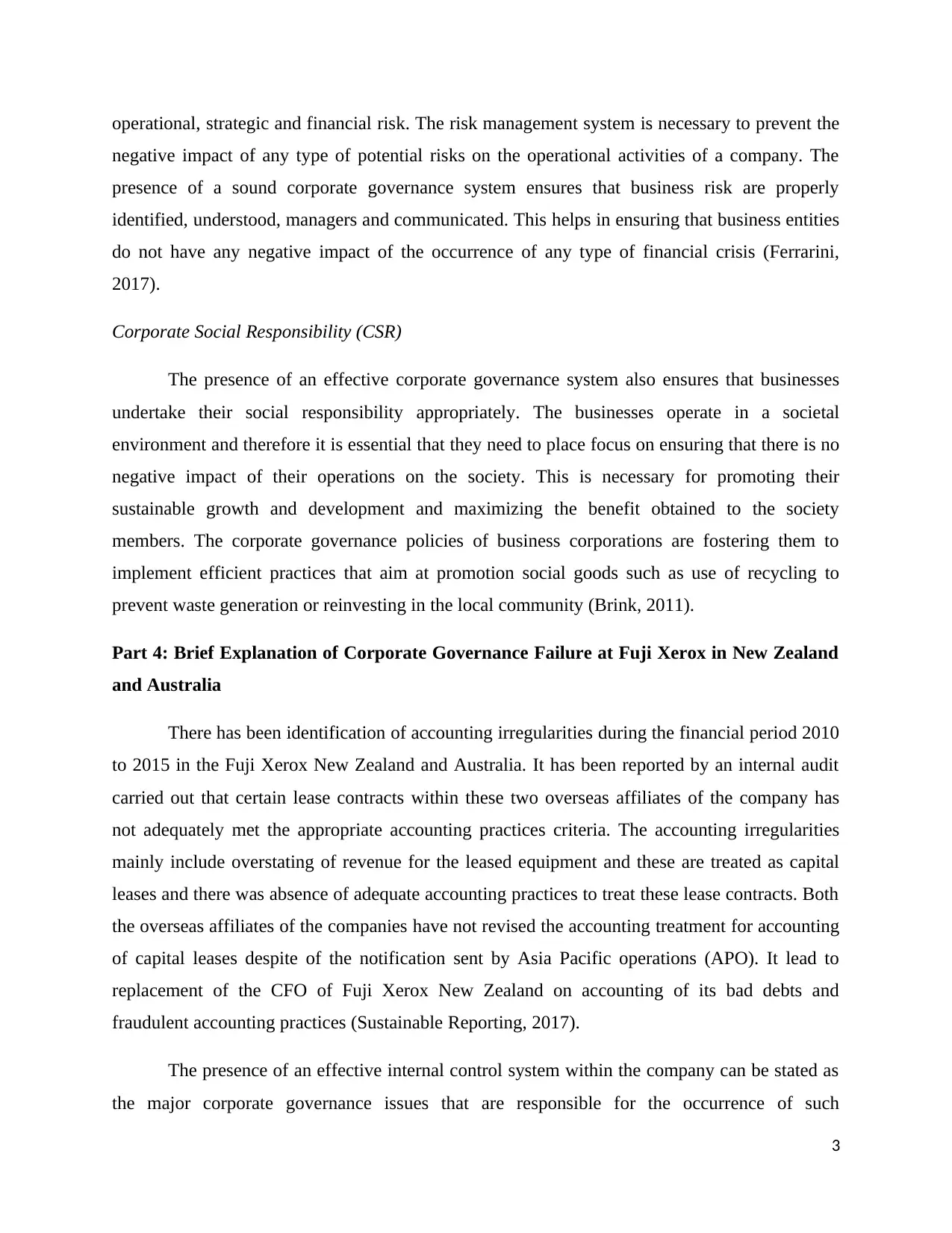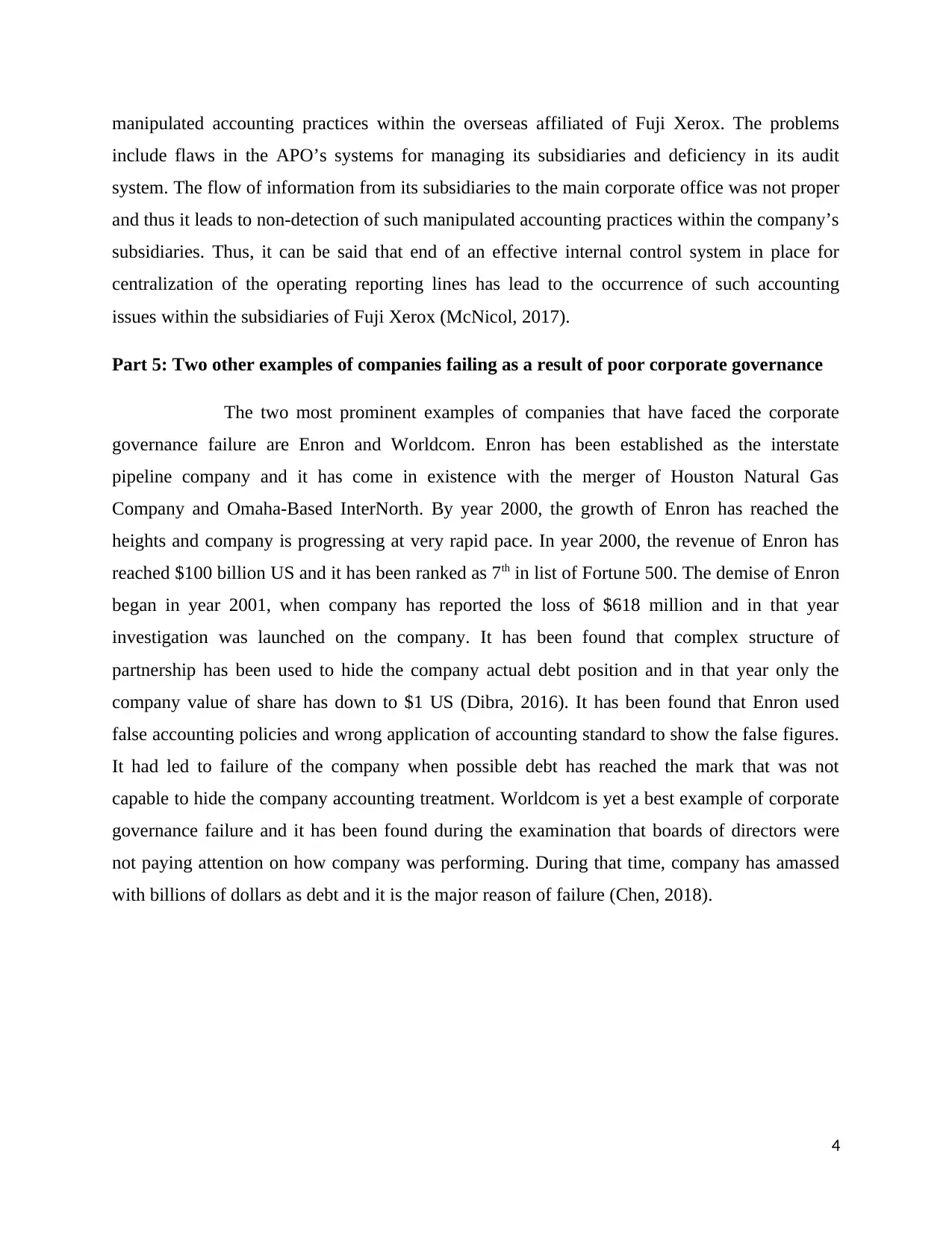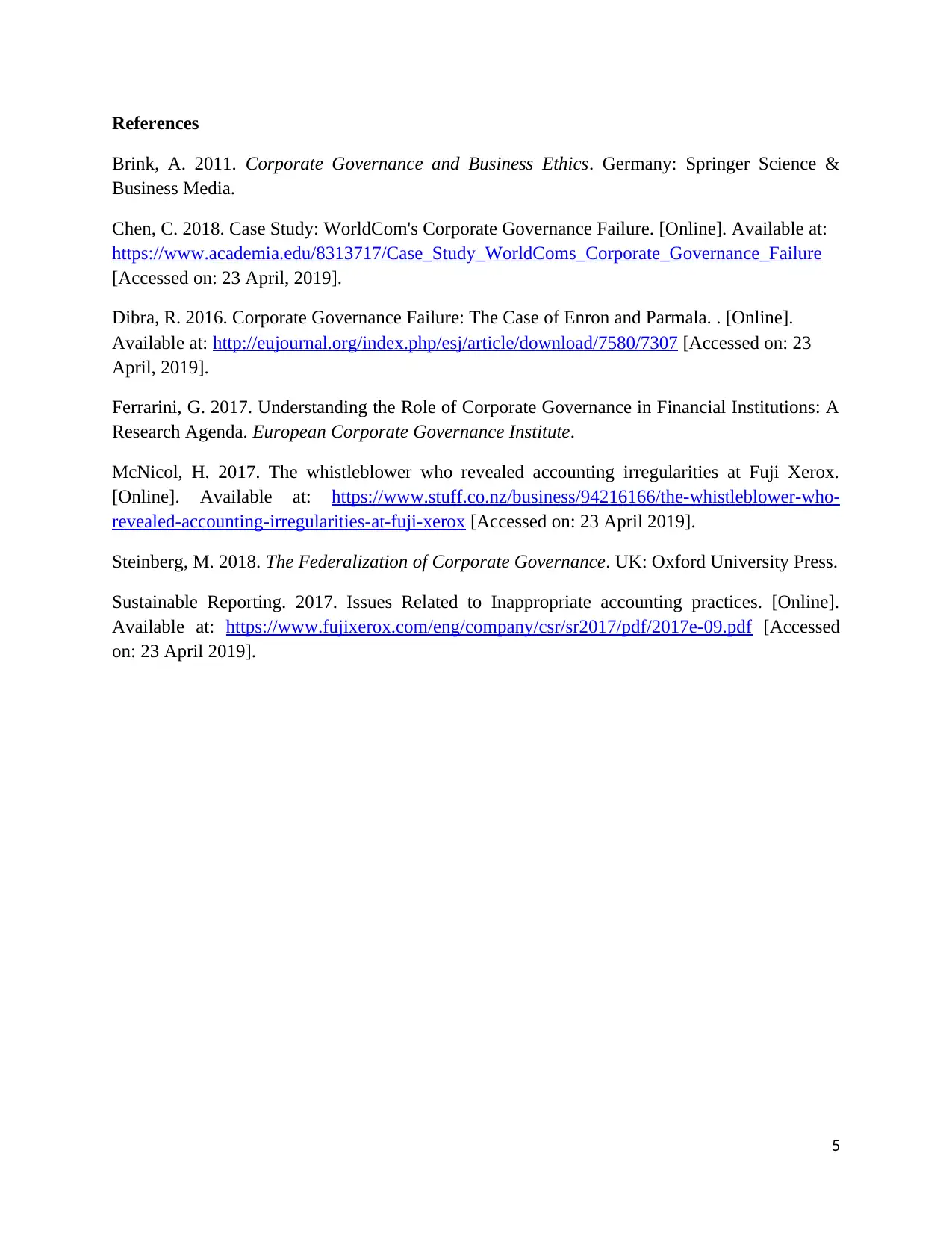Accounting Essay: Corporate Governance and Financial Market Analysis
VerifiedAdded on 2023/02/01
|5
|1358
|74
Essay
AI Summary
This essay explores the critical role of corporate governance in fostering robust and efficient financial systems. It defines corporate governance, emphasizing its function in establishing legal frameworks, specifying regulations, and promoting transparency within financial institutions. The essay highlights how effective corporate governance strengthens market disciplines, encourages investor confidence, and mitigates agency conflicts. It then delves into key factors indicative of strong corporate governance, including clear organizational strategies, robust risk management systems, and a commitment to corporate social responsibility. Furthermore, the essay examines the corporate governance failures at Fuji Xerox in New Zealand and Australia, identifying accounting irregularities and internal control deficiencies as contributing factors. Finally, it provides two additional examples of companies that failed due to poor corporate governance: Enron and Worldcom, detailing the causes and consequences of their respective downfalls.

Accounting
1
1
Paraphrase This Document
Need a fresh take? Get an instant paraphrase of this document with our AI Paraphraser

Part 2: Role of Corporate Governance in the Financial Markets
Corporate governance can be regarded as a major role in promoting the development of
robust and efficient financial systems. It is because it enables in developing an efficient legal
framework within financial institutions such as banks by specifying the rules and regulations that
need to be followed by its directors, shareholders and other stakeholders. It also specifies the
disclosure requirements that need to be followed by businesses by promoting the enforcement of
legal laws and procedures (Steinberg, 2018). It leads to strengthening of the market disciplines of
banks by promoting the faith of investors in the functioning of banking operations and thus
ensuring that they continually invest within the banks so that they are able to meet their capital
needs. The enforcement of the legal and regulatory structures is considered to be very essential
for promoting transparency and accountability within the capital market. The presence of
adequate legal structures and processes ensures that business managers are acting in their best
interests for protecting the rights of the shareholders and maximizing the value created for the
same. As such, it helps in reducing the problem of agency conflict that can negatively impact the
growth and development of the financial markets (Ferrarini, 2017.)
Part 3: Explanation of Three Factors Indicating Strong Corporate Governance of a
Company
Clear Organizational Strategy
The presence of good corporate governance within an organization begins with
development of a clear strategy that defines the plan of promoting its long-term growth. The
organizational strategy helps in guiding the business managers to develop strategic plans to
achieve the determined goals and objectives. It helps in developing strategic vision and mission
for promoting business growth and development and thus facilitating in meeting the needs of its
different stakeholder groups (Brink, 2011).
Strong Risk Management system
The presence of an effective corporate governance management system within an
organization also requires developing a sound risk management system. This implies
development of efficient policies and procedures to identify and mitigate any type of
2
Corporate governance can be regarded as a major role in promoting the development of
robust and efficient financial systems. It is because it enables in developing an efficient legal
framework within financial institutions such as banks by specifying the rules and regulations that
need to be followed by its directors, shareholders and other stakeholders. It also specifies the
disclosure requirements that need to be followed by businesses by promoting the enforcement of
legal laws and procedures (Steinberg, 2018). It leads to strengthening of the market disciplines of
banks by promoting the faith of investors in the functioning of banking operations and thus
ensuring that they continually invest within the banks so that they are able to meet their capital
needs. The enforcement of the legal and regulatory structures is considered to be very essential
for promoting transparency and accountability within the capital market. The presence of
adequate legal structures and processes ensures that business managers are acting in their best
interests for protecting the rights of the shareholders and maximizing the value created for the
same. As such, it helps in reducing the problem of agency conflict that can negatively impact the
growth and development of the financial markets (Ferrarini, 2017.)
Part 3: Explanation of Three Factors Indicating Strong Corporate Governance of a
Company
Clear Organizational Strategy
The presence of good corporate governance within an organization begins with
development of a clear strategy that defines the plan of promoting its long-term growth. The
organizational strategy helps in guiding the business managers to develop strategic plans to
achieve the determined goals and objectives. It helps in developing strategic vision and mission
for promoting business growth and development and thus facilitating in meeting the needs of its
different stakeholder groups (Brink, 2011).
Strong Risk Management system
The presence of an effective corporate governance management system within an
organization also requires developing a sound risk management system. This implies
development of efficient policies and procedures to identify and mitigate any type of
2

operational, strategic and financial risk. The risk management system is necessary to prevent the
negative impact of any type of potential risks on the operational activities of a company. The
presence of a sound corporate governance system ensures that business risk are properly
identified, understood, managers and communicated. This helps in ensuring that business entities
do not have any negative impact of the occurrence of any type of financial crisis (Ferrarini,
2017).
Corporate Social Responsibility (CSR)
The presence of an effective corporate governance system also ensures that businesses
undertake their social responsibility appropriately. The businesses operate in a societal
environment and therefore it is essential that they need to place focus on ensuring that there is no
negative impact of their operations on the society. This is necessary for promoting their
sustainable growth and development and maximizing the benefit obtained to the society
members. The corporate governance policies of business corporations are fostering them to
implement efficient practices that aim at promotion social goods such as use of recycling to
prevent waste generation or reinvesting in the local community (Brink, 2011).
Part 4: Brief Explanation of Corporate Governance Failure at Fuji Xerox in New Zealand
and Australia
There has been identification of accounting irregularities during the financial period 2010
to 2015 in the Fuji Xerox New Zealand and Australia. It has been reported by an internal audit
carried out that certain lease contracts within these two overseas affiliates of the company has
not adequately met the appropriate accounting practices criteria. The accounting irregularities
mainly include overstating of revenue for the leased equipment and these are treated as capital
leases and there was absence of adequate accounting practices to treat these lease contracts. Both
the overseas affiliates of the companies have not revised the accounting treatment for accounting
of capital leases despite of the notification sent by Asia Pacific operations (APO). It lead to
replacement of the CFO of Fuji Xerox New Zealand on accounting of its bad debts and
fraudulent accounting practices (Sustainable Reporting, 2017).
The presence of an effective internal control system within the company can be stated as
the major corporate governance issues that are responsible for the occurrence of such
3
negative impact of any type of potential risks on the operational activities of a company. The
presence of a sound corporate governance system ensures that business risk are properly
identified, understood, managers and communicated. This helps in ensuring that business entities
do not have any negative impact of the occurrence of any type of financial crisis (Ferrarini,
2017).
Corporate Social Responsibility (CSR)
The presence of an effective corporate governance system also ensures that businesses
undertake their social responsibility appropriately. The businesses operate in a societal
environment and therefore it is essential that they need to place focus on ensuring that there is no
negative impact of their operations on the society. This is necessary for promoting their
sustainable growth and development and maximizing the benefit obtained to the society
members. The corporate governance policies of business corporations are fostering them to
implement efficient practices that aim at promotion social goods such as use of recycling to
prevent waste generation or reinvesting in the local community (Brink, 2011).
Part 4: Brief Explanation of Corporate Governance Failure at Fuji Xerox in New Zealand
and Australia
There has been identification of accounting irregularities during the financial period 2010
to 2015 in the Fuji Xerox New Zealand and Australia. It has been reported by an internal audit
carried out that certain lease contracts within these two overseas affiliates of the company has
not adequately met the appropriate accounting practices criteria. The accounting irregularities
mainly include overstating of revenue for the leased equipment and these are treated as capital
leases and there was absence of adequate accounting practices to treat these lease contracts. Both
the overseas affiliates of the companies have not revised the accounting treatment for accounting
of capital leases despite of the notification sent by Asia Pacific operations (APO). It lead to
replacement of the CFO of Fuji Xerox New Zealand on accounting of its bad debts and
fraudulent accounting practices (Sustainable Reporting, 2017).
The presence of an effective internal control system within the company can be stated as
the major corporate governance issues that are responsible for the occurrence of such
3
⊘ This is a preview!⊘
Do you want full access?
Subscribe today to unlock all pages.

Trusted by 1+ million students worldwide

manipulated accounting practices within the overseas affiliated of Fuji Xerox. The problems
include flaws in the APO’s systems for managing its subsidiaries and deficiency in its audit
system. The flow of information from its subsidiaries to the main corporate office was not proper
and thus it leads to non-detection of such manipulated accounting practices within the company’s
subsidiaries. Thus, it can be said that end of an effective internal control system in place for
centralization of the operating reporting lines has lead to the occurrence of such accounting
issues within the subsidiaries of Fuji Xerox (McNicol, 2017).
Part 5: Two other examples of companies failing as a result of poor corporate governance
The two most prominent examples of companies that have faced the corporate
governance failure are Enron and Worldcom. Enron has been established as the interstate
pipeline company and it has come in existence with the merger of Houston Natural Gas
Company and Omaha-Based InterNorth. By year 2000, the growth of Enron has reached the
heights and company is progressing at very rapid pace. In year 2000, the revenue of Enron has
reached $100 billion US and it has been ranked as 7th in list of Fortune 500. The demise of Enron
began in year 2001, when company has reported the loss of $618 million and in that year
investigation was launched on the company. It has been found that complex structure of
partnership has been used to hide the company actual debt position and in that year only the
company value of share has down to $1 US (Dibra, 2016). It has been found that Enron used
false accounting policies and wrong application of accounting standard to show the false figures.
It had led to failure of the company when possible debt has reached the mark that was not
capable to hide the company accounting treatment. Worldcom is yet a best example of corporate
governance failure and it has been found during the examination that boards of directors were
not paying attention on how company was performing. During that time, company has amassed
with billions of dollars as debt and it is the major reason of failure (Chen, 2018).
4
include flaws in the APO’s systems for managing its subsidiaries and deficiency in its audit
system. The flow of information from its subsidiaries to the main corporate office was not proper
and thus it leads to non-detection of such manipulated accounting practices within the company’s
subsidiaries. Thus, it can be said that end of an effective internal control system in place for
centralization of the operating reporting lines has lead to the occurrence of such accounting
issues within the subsidiaries of Fuji Xerox (McNicol, 2017).
Part 5: Two other examples of companies failing as a result of poor corporate governance
The two most prominent examples of companies that have faced the corporate
governance failure are Enron and Worldcom. Enron has been established as the interstate
pipeline company and it has come in existence with the merger of Houston Natural Gas
Company and Omaha-Based InterNorth. By year 2000, the growth of Enron has reached the
heights and company is progressing at very rapid pace. In year 2000, the revenue of Enron has
reached $100 billion US and it has been ranked as 7th in list of Fortune 500. The demise of Enron
began in year 2001, when company has reported the loss of $618 million and in that year
investigation was launched on the company. It has been found that complex structure of
partnership has been used to hide the company actual debt position and in that year only the
company value of share has down to $1 US (Dibra, 2016). It has been found that Enron used
false accounting policies and wrong application of accounting standard to show the false figures.
It had led to failure of the company when possible debt has reached the mark that was not
capable to hide the company accounting treatment. Worldcom is yet a best example of corporate
governance failure and it has been found during the examination that boards of directors were
not paying attention on how company was performing. During that time, company has amassed
with billions of dollars as debt and it is the major reason of failure (Chen, 2018).
4
Paraphrase This Document
Need a fresh take? Get an instant paraphrase of this document with our AI Paraphraser

References
Brink, A. 2011. Corporate Governance and Business Ethics. Germany: Springer Science &
Business Media.
Chen, C. 2018. Case Study: WorldCom's Corporate Governance Failure. [Online]. Available at:
https://www.academia.edu/8313717/Case_Study_WorldComs_Corporate_Governance_Failure
[Accessed on: 23 April, 2019].
Dibra, R. 2016. Corporate Governance Failure: The Case of Enron and Parmala. . [Online].
Available at: http://eujournal.org/index.php/esj/article/download/7580/7307 [Accessed on: 23
April, 2019].
Ferrarini, G. 2017. Understanding the Role of Corporate Governance in Financial Institutions: A
Research Agenda. European Corporate Governance Institute.
McNicol, H. 2017. The whistleblower who revealed accounting irregularities at Fuji Xerox.
[Online]. Available at: https://www.stuff.co.nz/business/94216166/the-whistleblower-who-
revealed-accounting-irregularities-at-fuji-xerox [Accessed on: 23 April 2019].
Steinberg, M. 2018. The Federalization of Corporate Governance. UK: Oxford University Press.
Sustainable Reporting. 2017. Issues Related to Inappropriate accounting practices. [Online].
Available at: https://www.fujixerox.com/eng/company/csr/sr2017/pdf/2017e-09.pdf [Accessed
on: 23 April 2019].
5
Brink, A. 2011. Corporate Governance and Business Ethics. Germany: Springer Science &
Business Media.
Chen, C. 2018. Case Study: WorldCom's Corporate Governance Failure. [Online]. Available at:
https://www.academia.edu/8313717/Case_Study_WorldComs_Corporate_Governance_Failure
[Accessed on: 23 April, 2019].
Dibra, R. 2016. Corporate Governance Failure: The Case of Enron and Parmala. . [Online].
Available at: http://eujournal.org/index.php/esj/article/download/7580/7307 [Accessed on: 23
April, 2019].
Ferrarini, G. 2017. Understanding the Role of Corporate Governance in Financial Institutions: A
Research Agenda. European Corporate Governance Institute.
McNicol, H. 2017. The whistleblower who revealed accounting irregularities at Fuji Xerox.
[Online]. Available at: https://www.stuff.co.nz/business/94216166/the-whistleblower-who-
revealed-accounting-irregularities-at-fuji-xerox [Accessed on: 23 April 2019].
Steinberg, M. 2018. The Federalization of Corporate Governance. UK: Oxford University Press.
Sustainable Reporting. 2017. Issues Related to Inappropriate accounting practices. [Online].
Available at: https://www.fujixerox.com/eng/company/csr/sr2017/pdf/2017e-09.pdf [Accessed
on: 23 April 2019].
5
1 out of 5
Related Documents
Your All-in-One AI-Powered Toolkit for Academic Success.
+13062052269
info@desklib.com
Available 24*7 on WhatsApp / Email
![[object Object]](/_next/static/media/star-bottom.7253800d.svg)
Unlock your academic potential
Copyright © 2020–2025 A2Z Services. All Rights Reserved. Developed and managed by ZUCOL.





